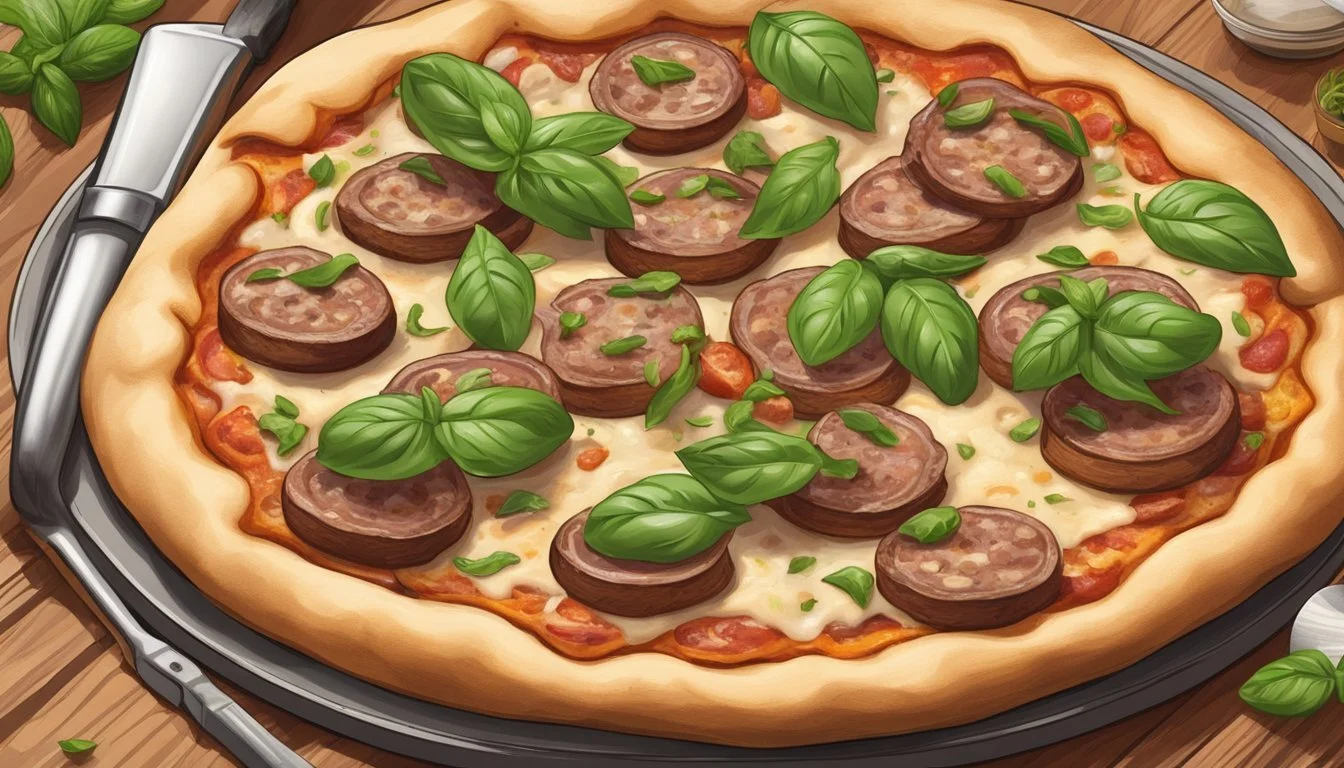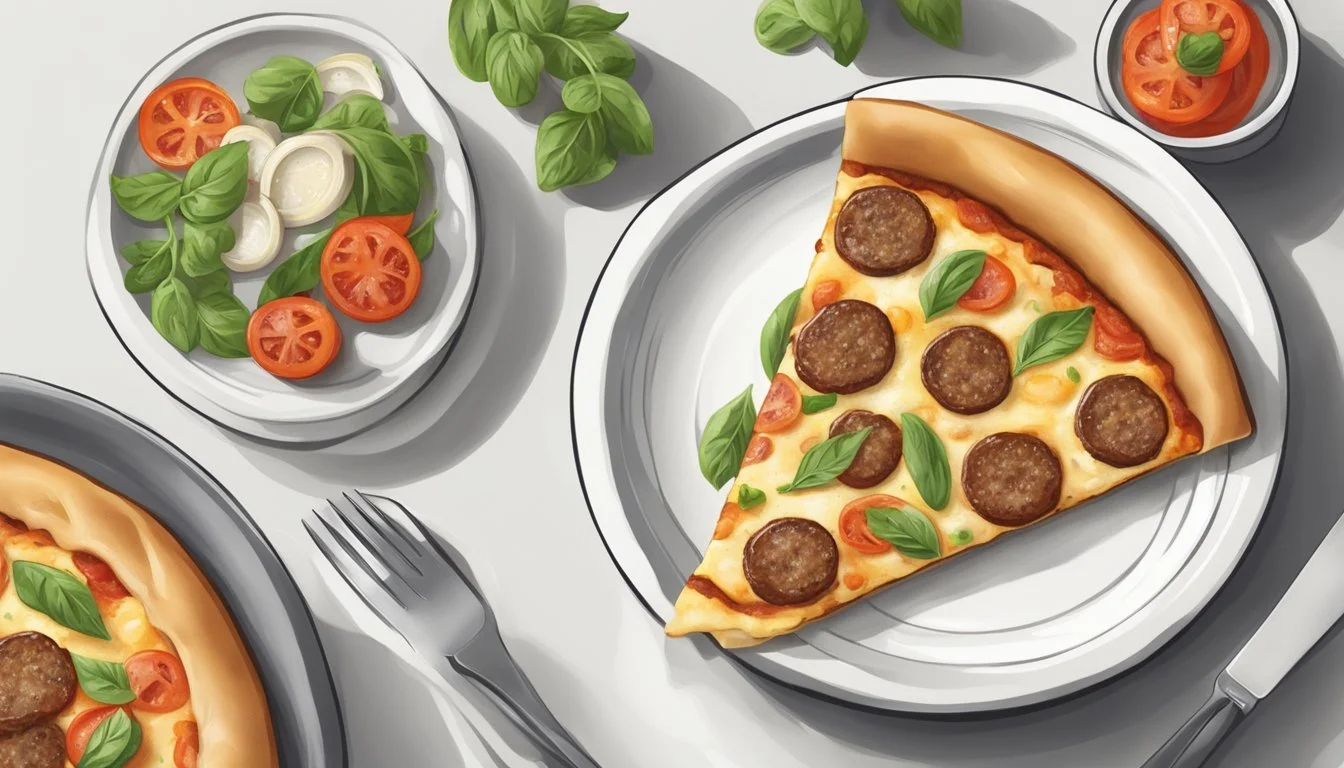How Long Does Flatbread Sausage Pizza Last?
Storage Tips and Shelf Life
Flatbread sausage pizza makes for a delightful and convenient dinner option, combining the aromatic flavors of Italian sausage with the crispy texture of flatbread. One common concern is how long this delicious meal will last. Properly stored, flatbread sausage pizza can last about 3-4 days in the refrigerator.
For those who love meal prepping or cooking in batches, flatbread sausage pizza could be an excellent addition to the weekly menu. Whether you've followed a detailed recipe or thrown together your favorite toppings, its simplicity pairs well with a variety of side dishes, making it a versatile choice for busy weeknights.
Keep in mind that the quality of the ingredients, including the Italian sausage and the type of flatbread, can affect the storage time. Ensuring all components are well-cooked and stored quickly after cooling can help maintain the freshness and safety of your pizza.
Overview of Flatbread Sausage Pizza
Flatbread sausage pizza is a popular choice for many due to its thin, crispy crust and flavorful toppings. It typically features flatbread as the base, topped with sausage, cheese, and various vegetables.
Ingredients commonly include:
Flatbread: The foundation of the pizza, offering a thin and crispy texture.
Italian Sausage: Adds a robust and savory flavor.
Cheese: Mozzarella and sometimes ricotta.
Vegetables: Common options are bell peppers, broccoli, and cauliflower.
Cooking Instructions usually highlight baking the pizza at high temperatures. Common practices include preheating the oven anywhere between 350°F to 450°F. Cooking times generally range from 8 to 25 minutes, depending on the recipe and oven.
Variations
Italian Sausage Flatbread Pizza: Known for its rich flavor, often including Italian sausage, mozzarella, and roasted vegetables.
Pepperoni Flatbread Pizza: A classic version featuring pepperoni slices alongside sausage.
The selection of vegetables can vary, with bell peppers being a popular choice. The combination of these ingredients creates a balanced pizza with multiple flavor profiles.
Making flatbread sausage pizza at home allows for customization. One can adjust the toppings based on personal preference, making it versatile and appealing to different tastes. The use of pre-cooked sausage and pre-baked flatbread simplifies the preparation process, making it accessible for home cooks.
Ingredients and Nutritional Information
Flatbread sausage pizza combines a variety of ingredients, each contributing to the overall taste and nutritional profile.
Key Ingredients
A typical flatbread sausage pizza includes flatbread, Italian sausage, mozzarella cheese, pizza sauce, and optional toppings like basil, tomatoes, peppers, and onions. The flatbread serves as the base, providing a crispy texture.
Italian sausage adds a savory, spicy flavor enhanced by seasonings like fennel and garlic. Mozzarella cheese is common for its melting properties and mild taste. Pizza sauce is usually tomato-based, adding moisture and tang.
Optional ingredients like basil, tomatoes, peppers, and onions can enhance flavor and add nutritional value such as vitamins and fiber.
Nutritional Breakdown
The calorie content and nutritional value vary based on ingredients and portion size. For instance, a flatbread sausage pizza from Nutritionix has 859 calories per serving. Breakdown:
Total Fat: 50g (64% of daily value)
Saturated Fat: 23g (115%)
Trans Fat: 0g
Polyunsaturated Fat: 5.4g
Monounsaturated Fat: 23g
Carbohydrates: Approximately 9-35g depending on the recipe
Protein: High due to sausage and cheese content
Cholesterol: Varies by sausage and cheese used
Sodium: Highlighted at around 870mg in some recipes
Key nutrient focus includes balancing protein, saturated fat, and sodium intake. The cheese and sausage contribute significantly to these values, while vegetables provide necessary fiber and vitamins without adding excessive calories.
Preparation and Cooking Instructions
Creating a delicious flatbread sausage pizza involves a few critical steps, including making the dough, assembling the pizza, and using proper baking techniques for the best results.
Creating the Dough
Homemade flatbread can significantly enhance the quality of your pizza. For a basic dough recipe, combine 2 cups of flour, 1 teaspoon of salt, 1 teaspoon of sugar, 2 teaspoons of active yeast, and 3/4 cup of warm water. Knead until smooth and let it rise for about an hour.
For those short on time, store-bought flatbreads or naan bread are excellent alternatives that offer convenience without sacrificing flavor.
Whether you opt for homemade or store-bought, ensure the base is rolled out to the desired thickness to achieve a crispy or chewy crust.
Assembling the Pizza
Begin by preheating your oven to around 425°F (220°C). Lay your flatbread on a baking sheet or pizza stone. Start spreading a thin layer of olive oil and minced garlic to create a fragrant base.
Next, add your pizza sauce, allowing a 1/4-inch border. Layer on shredded mozzarella cheese, cooked Italian sausage, and vegetables like bell peppers, zucchini, and onions as desired.
Finally, sprinkle additional toppings such as dollops of ricotta or a handful of fresh basil leaves for added flavor.
Baking and Cooking Tips
To achieve a perfectly cooked flatbread sausage pizza, bake at 425°F for 8-12 minutes, keeping an eye on the crust’s edges until they turn golden brown and the cheese is fully melted.
For a crispier texture, use a pizza stone or preheated baking sheet. Alternatively, an air fryer can provide a rapid cook time and evenly crispy finish.
Avoid overloading the pizza with toppings to ensure even cooking. Allow the pizza to cool for a couple of minutes before slicing to prevent the cheese from sliding off and to maintain a solid structure.
Experimenting with cook times and temperatures can help achieve your preferred level of crispiness and flavor.
Storage and Shelf Life
Proper storage ensures that flatbread sausage pizza remains safe to eat and retains its flavor. Key factors include refrigeration, using airtight containers, and understanding how long it can last under different conditions.
Proper Storage Techniques
To maintain the freshness of flatbread sausage pizza, it should be stored in an airtight container immediately after it cools to room temperature. When using the refrigerator, wrap the pizza slices individually. This approach avoids sogginess and ensures even cooling. Plastic wrap or aluminum foil can be used for this purpose.
Another method is to cover the whole pizza with a layer of olive oil to preserve moisture before wrapping. If freezing, place the pizza on a baking sheet to firm up first, then transfer to a freezer-safe bag. This prevents the slices from sticking together. Labeling the containers with the date helps keep track of storage time.
Shelf Life Considerations
The shelf life of flatbread sausage pizza varies based on storage conditions. When stored in the refrigerator, it lasts three to four days. Ensure the pizza is kept at a consistent temperature to avoid spoilage. Look for signs of deterioration, such as changes in color or texture.
If properly wrapped and placed in the freezer, the flatbread sausage pizza can last up to 2 months. Ingredients like mozzarella cheese, tomatoes, bell peppers, Italian sausage, and ricotta cheese maintain their quality better under these conditions. Plan to consume frozen pizza within this time frame for optimal taste and safety.
Serving Suggestions
Flatbread Sausage Pizza can be a versatile dish suitable for dinner, lunch, or as a party appetizer. To enhance the culinary experience, consider pairing this pizza with complementary sides and beverages.
Appropriate Accompaniments
Salads: A fresh salad with crisp veggies, dressed in olive oil and balsamic vinegar, pairs beautifully with the savory notes of Flatbread Sausage Pizza. Consider a salad of mixed greens with basil and oregano, or a classic Caesar salad.
Roasted Vegetables: Roasted vegetables can add depth to your meal. Try pairing your pizza with roasted bell peppers, broccoli, or cauliflower, seasoned with Italian seasoning and olive oil. The roasted flavors harmonize well with the pizza's rich sausage and cheese toppings.
Breadsticks and Dips: Serve some warm breadsticks with a side of marinara sauce for dipping. This can be a delightful addition especially for guests who enjoy diversifying their bites.
Wine and Beverage Pairings
Wines: A medium-bodied red wine like Chianti or a Sangiovese complements Flatbread Sausage Pizza nicely. These wines' slight acidity and fruitiness balance the richness of the sausage and cheese.
Beer: For beer lovers, an Italian lager or a crisp pilsner can make a great pairing, providing a refreshing contrast to the flavors of the pizza.
Non-alcoholic Options: For non-drinkers, consider offering sparkling water with a twist of lemon or lime. A cold iced tea infused with basil can also be a refreshing choice, enhancing the Italian flavor profile.
Customization and Variations
For those looking to tailor their flatbread sausage pizza experience, a variety of toppings and cheeses can be used, catering to personal tastes and dietary preferences.
Alternative Toppings and Cheeses
A flatbread sausage pizza can be easily customized with an assortment of toppings and cheeses. Ricotta cheese adds a creamy texture, while Parmesan delivers a sharp, nutty flavor. Fresh mozzarella can be used for a meltier, more traditional option.
Meat lovers can experiment with ham, bacon, and pepperoni for added savory richness. Vegetables such as black olives, bell peppers, and onions provide balanced flavors and extra nutrition. For a slightly different twist, zucchini and mushrooms can be incorporated, adding depth and complexity to the taste profile.
Tomatoes also make a great addition as they can be paired with Italian seasoning for enhanced flavor. This customization results in a more personal pizza experience that can satisfy varied palates.
Vegan and Vegetarian Options
For those following a vegan or vegetarian diet, there are ample choices to modify flatbread sausage pizza appropriately. Vegan cheese can replace traditional dairy-based cheeses, offering plant-based alternatives that melt well and taste good.
Mushrooms, bell peppers, and onions provide flavorful, hearty toppings, while zucchini and tomatoes add freshness and moisture. The sausage can be substituted with plant-based sausage to maintain the core element of the dish.
Another excellent option is to use generous spoonfuls of ricotta made from nuts, which provides creaminess without using dairy. With these changes, a flatbread sausage pizza can be both delicious and suitable for vegan and vegetarian eaters.
Safety and Health Considerations
When storing flatbread sausage pizza, it's crucial to prioritize safety and health.
Keep the pizza refrigerated within two hours of cooking. This timeframe prevents bacteria growth.
Proper Storage: Flatbread sausage pizza can last up to 4 days in the fridge at a temperature below 40°F (4°C).
Reheating: Use an oven preheated to 350°F (175°C) for 10-15 minutes until thoroughly heated.
Nutritional Considerations
Italian Sausage: This flavor-packed ingredient adds taste but also increases sodium and saturated fat levels.
Sodium: High sodium can impact blood pressure.
Cholesterol: Regular consumption may elevate cholesterol levels.
Saturated Fat: Look for leaner sausage options to manage intake.
Carbohydrates and Fiber
Flatbread provides a source of carbohydrates, necessary for energy, but should be balanced with fiber-rich foods in your meals.
Sugar Content
Ensure the flatbread does not have added sugars, which can contribute to unwanted calorie intake.
Health Tips
Opt for whole-grain flatbread to improve fiber intake.
Pair with vegetables to add nutrients and reduce calorie density.
Monitor portions to maintain balanced eating habits.









